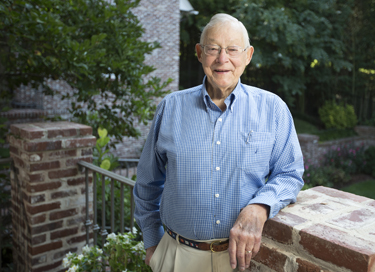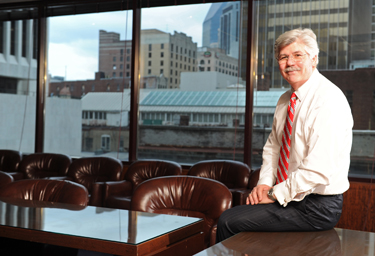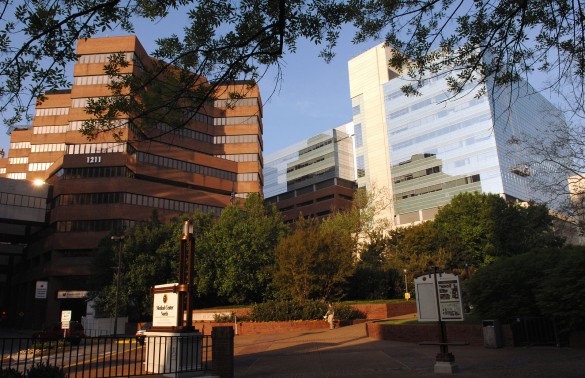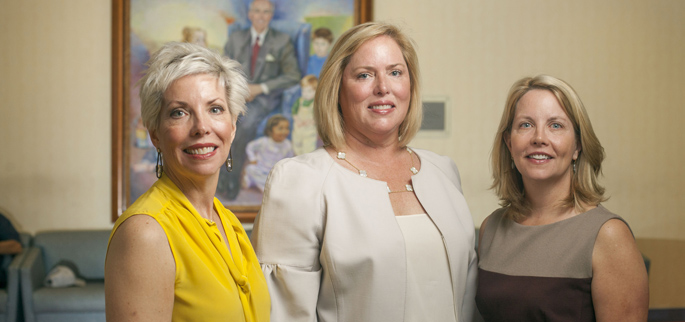John Stein and Bob McNeilly Jr. were students at Vanderbilt University decades apart. One studied biology, the other education. One was a Nashville native, the other from Florida.
For both of the men, however, their time at Vanderbilt was the foundation for a longstanding tradition of dedication to the University and Medical Center and their missions. And through the past six decades, these relationships have translated into valuable financial contributions and countless hours of time in support of the institution.

“Bob and John formed deep connections with Vanderbilt during their days as students, resulting in life-long relationships that today impact all of us,” said Jeff Balser, M.D., Ph.D., vice chancellor for Health Affairs and dean of the School of Medicine. “Whether it is advancing scholarship or constructing new facilities, these individuals not only participate, they lead.”
John Stein
The beginning of Stein’s more than four-decade relationship with Vanderbilt was when he stepped foot on campus as a college freshman. It was 1969, and the Sarasota, Florida, native had arrived in Nashville as a member of the swimming team.

“I knew very little about Nashville or Tennessee, or, candidly, very little about Vanderbilt,” Stein said.
That changed over the years as Stein completed his degree and then stayed for another, earning his master’s in business from the Owen Graduate School of Management and then landed a job as a banking executive.
Today, Stein serves as president of Bank of America in Tennessee and manages the financial institution’s relationships with health care entities across the country. And in his role, he has led the bank’s efforts to support Vanderbilt through the years.
“Vanderbilt has an incredible impact on not just the Nashville community, but its impact can be felt nationally and internationally,” Stein said, “whether you’re talking about Children’s Hospital or Vanderbilt University Hospital or the fabulous research. Anything we can do as a bank to give back is certainly a high priority.”
This year marked Bank of America’s 25th anniversary as presenting sponsor of the Iroquois Steeplechase, an event that benefits Monroe Carell Jr. Children’s Hospital at Vanderbilt and has led to nearly $10 million in event proceeds since 1981.
The bank also has been a key supporter of the Medical Center during recent expansion projects.
During the height of the recent economic downturn, Children’s Hospital was amid a 30,000-square-foot expansion project to add 33 beds. To help with the capital campaign for the project, Bank of America donated $1 million.
“We did that not only to support the Medical Center but also to send a message to the community that, not only is this is important, but everyone needs to get behind it,” Stein said.
The bank also provided Vanderbilt support to help buffer the effects of the recession, Stein said.
“It was during a time when universities across the country were being stressed, during a time when that was a difficult thing to do,” Stein said. “But we thought it was important, and it’s the least we can do to help support the fabulous organization that Vanderbilt is.”
The bank has also played an active role in supporting other initiatives at Vanderbilt, from academics to athletics. And Stein has given his personal time, serving on the Medical Center Board and as the chair and a member of the Children’s Hospital board.
During that time, Stein’s personal connection to the school has continued — his son is a recent graduate.
“As an observer and participant of Vanderbilt life for 46 years, it’s been wonderful to see the organization strengthen and improve, whether you’re talking about athletic success or all the many things academically,” Stein said. “It’s been extraordinary to watch that prosper and develop. That’s been hugely gratifying.”
Bob McNeilly Jr.
McNeilly spent decades in the commercial printing industry after earning his bachelor’s and master’s degrees from Vanderbilt.
But a turning point in his relationship with the University came in the 1970s when his daughter was seriously injured in a sledding accident.
“She was really on the point of death,” McNeilly said. “We took her to the Vanderbilt emergency room.”
After a team of doctors, including a neurosurgeon, an orthopaedic surgeon and a cardiologist, treated McNeilly’s daughter, she recovered from the incident.
“They saved her life,” McNeilly said.
Years later he got a chance to start giving back to the institution that he felt had given so much to him and the community. McNeilly reconnected with classmates from his years studying at Vanderbilt and became active with the alumni association.
“That was a real revelation because a couple times a year we had a presentation by Ike Robinson or Harry Jacobson (former vice chancellors for Health Affairs) about the state of Medical Center,” McNeilly said. “I was so impressed that I wanted to be more active in supporting the Medical Center.”
He joined the Canby Robinson Society, eventually serving as its president, and took part in efforts to raise money to establish one of its first scholarships.
“I had a network that I tried to cultivate on behalf of Vanderbilt,” McNeilly said.
That network also led to securing one of the largest private gifts that the School of Medicine had ever received for the purposes of establishing a fully endowed scholarship. McNeilly led the way in making the case for Vanderbilt and how important and impactful such a gift could be in his discussions with the donor.
The gift was also remarkable in that the donor’s only connection to the University was through the care provided by the Medical Center.
But his work to raise money for Vanderbilt wasn’t the only way that McNeilly has given back. For several years after he retired from his role with First American National Bank, he began to volunteer at the Medical Center.
At the Vanderbilt-Ingram Cancer Center, McNeilly spent time talking to patients at the Infusion Center, bringing around snack carts and refilling coffee pots throughout the center.
“There were 14 coffee pots, so that took a while,” McNeilly joked. “I was there really just to talk to the patients, try to be positive, try to see if I could lift their spirits.”
While his time volunteering and raising money for Vanderbilt has meant a great deal to McNeilly, he called his efforts a small gesture among many.
“I’m just a guy,” he said. “There are a lot of people who have also been active and contributed to Vanderbilt, and I’m just one of them.”















